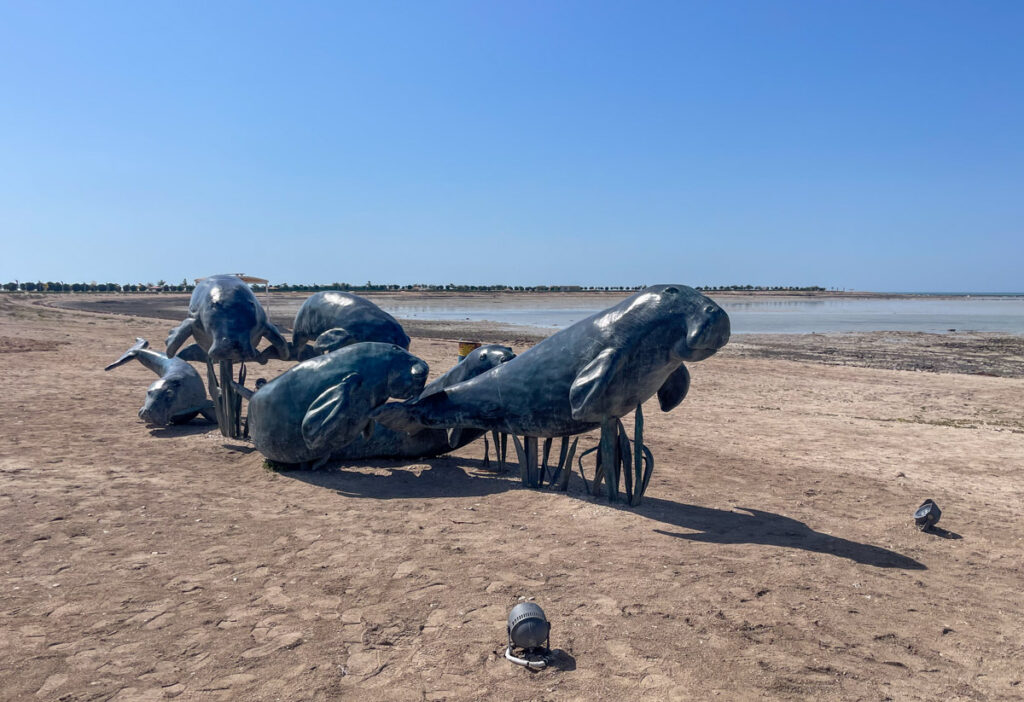Qatar is more than just Doha. Exploring the desert reveals lesser-known attractions that offer a captivating journey. Heading north, you can visit many interesting places, from Al Zubara Fort to Al Ruwais beach. This expedition provides a blend of history, art, and natural beauty. In this article, you will discover the diverse offerings of northern Qatar.
Table of Contents
What to see in the north of Qatar
Driving from Doha to northern Qatar, the landscape around you is mostly desert, interspersed with many local farms and factories that have made the Qatari economy independent of imports.
PLAN YOUR TRIP TO QATAR
During your trip to Qatar make sure you stay connected by purchasing Airalo eSIM online in advance, and avoid the hassle of buying a physical SIM at the airport.
In addition, remember to purchase Heymondo travel insurance that provides coverage against unexpected events such as medical emergencies, trip cancellations, lost luggage, and more. It offers great value for money and ensures a stress-free and enjoyable trip!
However, you can explore the intriguing Al Zubara archaeological site and witness the modern marvel of Baladna Milk Factory. And the unique installations like Olafur Eliasson’s mirrors in the desert and family-friendly spots like Al Khor Panda Park.
There are also cities populated by oil and gas company workers. Still, these are not very interesting from a tourist’s point of view unless you are reading this article and planning to move to Qatar to develop your career in this field.
Having a local guide, such as Palma from I Viaggi del Qatar, was crucial for me to appreciate the sights I visited and have a safe trip. As I will explain later, driving in the desert is not something you can do alone in a rented car, despite my extensive experience as a solo traveller.
With an experienced guide, from public art to archaeological areas, and some curious attractions like the famous local milk factory Baladna, I am pretty sure you will find the north of Qatar really intriguing. Keep reading to find out more.

Archaeological Areas: Uncovering Al Zubara and Jumail’s Heritage
The Al Zubara Fort, Al Zubara Archaeological Site, and Jumail abandoned village are captivating cultural attractions in North Qatar. The Al Zubara Fort is a remarkable historical site that provides insight into the region’s rich past, while the archaeological site and abandoned village add to the area’s cultural significance and allow you to discover ancient Qatari settlements.
Al Zubara Fort
Al Zubara Fort is a well-known sight in northern Qatar. Built in 1938, its strategic location made it an essential stronghold for protecting the trade routes and the region from external threats.
Along with a series of other forts along Qatar’s coastline, Al Zubara Fort formed part of a complex defence system controlling the sea and freshwater resources. Until 1986, the Fort was a military and police post, while now it is a museum and heritage attraction.
You can visit the Al Zubara Fort for a fee. It is open all year round, from Saturday to Thursday, 9 am to 5 pm, and 12:30 pm to 5 pm on Friday.

Al Zubara Archaeological Site
The Al Zubara Fort is adjacent to Qatar’s largest archaeological site. The now-abandoned town of Al Zubara was once a thriving cultural and political centre with an economy based on pearl fishing and trade. Excavations at the site have unearthed artefacts, structures, and evidence of a sophisticated urban settlement.
In 2013, the Al Zubarah Archaeological Site, which comprises the Fort and the old fishing village, was inscribed into the UNESCO World Heritage List.
To visit the Al Zubara Archaeological Site, you should arrive at the Fort when a free guided tour is available. Once there, you can see the ruins from a footbridge and gain insight into the daily lives, customs, and trading activities of the inhabitants who once thrived in this ancient port city.
At the time of writing, information about visiting the archaeological area is unclear. However, we were fortunate enough to arrive just in time for a tour. We boarded a minibus with other tourists and visited the site with a guide for free.

Jumail Abandoned Village
Not too far from the Al Zubara site, the abandoned village of Jumail is apparently undergoing a massive renovation, which includes rebuilding and re-plastering ancient houses. During my visit, there weren’t workers in the town, but the mosque looked freshly re-plastered, like new.
The ongoing renovation efforts raise questions about the delicate balance between preserving the authenticity of historic sites and the need for restoration and conservation.
Today, conservative restoration, in which the new parts are clearly different from the original ones, is always preferred. Bringing old buildings back to new is not a particularly popular restoration technique, however aesthetically pleasing it may be.
I recommend visiting Jumail as soon as possible to experience the evocative atmosphere of an abandoned village before the renovation is completed.

Public Art in Northern Qatar: Olafur Eliasson and Ahmed Al Bahrani
Northern Qatar can surprise you with some significant contemporary art installations. Olafur Eliasson’s “Shadows Travelling on the Sea of the Day” in the desert is a captivating artistic creation that pushes the boundaries of art and nature. Situated amid the desert landscape, Olafur Eliasson’s mirrors reflect and amplify natural sunlight. You can engage with the artwork, walk through the installation, and appreciate how it blurs the boundaries between art and nature.

Moving on to Al Ruwais beach, “The Dugong Family” by Ahmed Al Bahrani depicts dugongs swimming in their natural habitat. The Arabian Gulf is home to the world’s second-largest population of dugongs after Australia. Qatar recorded the largest herds of dugongs in the world, comprising 600 and 700 dugongs.

Experience Qatar’s Most Famous Company: Baladna Farm and Baladna Park
One of the most interesting attractions you can see in Qatar is the Baladna Farm. The company offers many dairy products, including cheese, laban, yoghurt, labneh, cream, desserts, and fresh milk.
Baladna aimed to meet Qatar’s total dairy demand and make the country self-sufficient, and it achieved this goal in just a few years. During the Qatar embargo, they imported 4000 cows by plane to kickstart production, and the number has multiplied since then.

At the farm, you can watch videos to learn how cows are bred. Calves stay in a nursery before moving to the cows’ area when they’re older. The farm produces around 400,000 litres of milk every day for various products, thanks to its comfortable and temperature-controlled environment where the cows have space to move freely.
I found Baladna’s highly technologised processes quite interesting. For instance, the company uses a rotatory milking parlour that you can see from the visitors’ area to make the process more efficient. At the same time, people and trucks are disinfected when entering the farm.

During winter, you can also access Baladna Park, a themed amusement park near the factory, perfect for families. The park covers 2.4 million square meters with lawns, gardens, and a zoo. Here, children can spend a fantastic day out and learn about milk production.
Al Khor Panda Park: Meet The First Qatari Pandas
The Al Khor Panda Park is home to two pandas in a specially designed panda habitat. Although I haven’t had the chance to visit yet, this spot is highly recommended for families with kids.
The pandas, originally from China, reside in one of the world’s largest panda habitats. Trained staff members provide care and interact with the pandas in Mandarin and English. They also learn the Sichuan dialect to ensure the pandas feel at home in Qatar.
Why You Need an Expert Local Guide to Explore the North of Qatar
When planning a trip to the north of Qatar through the desert, I recommend hiring an expert local guide. In fact, there are several compelling reasons for choosing a guide over attempting the journey alone, even if you are an expert traveller like me.
Firstly, renting a car and embarking on this journey independently is not advisable due to insurance limitations. Many standard car rental insurance policies do not cover driving in the desert, leaving you at risk of significant financial liabilities in mishaps or accidents.

Moreover, driving in the desert presents a unique set of challenges. While there are good roads leading north, roads to archaeological areas or sights like Olafur Eliasson’s mirrors are mostly unpaved and literally in the middle of the desert.
For this reason, the possibility of encountering unexpected obstacles, such as punctured tyres, cannot be overlooked. Without the appropriate experience and resources, finding oneself stranded in the desert, waiting for help for hours, and possibly with limited water can quickly turn into a dangerous and distressing situation.
By engaging an expert local guide, like one from I Viaggi del Qatar you can benefit from their extensive knowledge of the terrain, as well as their ability to navigate potential obstacles and minimise risks. A guide can provide valuable insights into the best routes and destinations, ensure proper vehicle maintenance, and offer essential support in the event of any unforeseen circumstances.

Where to stay in Doha
Doha boasts a wide range of beautiful hotels with swimming pools and fitness centers to choose from. DoubleTree by Hilton Doha Old Town is a great modern accommodation in the heart of Doha. For a sea view option, you can choose the Wyndham Grand Doha West Bay Beach. If you prefer to stay in a hotel with an Arabian touch, I can recommend La Maison Hotel Doha, or for a luxurious experience, the incredible Sharq Village & Spa, a Ritz-Carlton Hotel.
In conclusion, exploring the northern region of Qatar offers a rich tapestry of cultural, historical, and natural wonders. From the ancient Al Zubara Fort and Archaeological Site to the contemporary art installations, you can immerse yourself in Qatari culture and heritage. Whether you are drawn to history, art, or simply the allure of undiscovered landscapes, share your thoughts in the comments.
